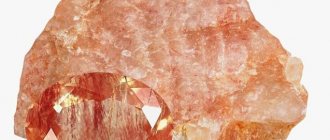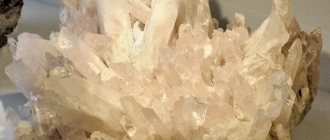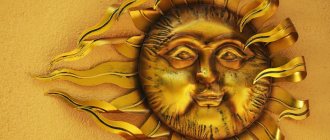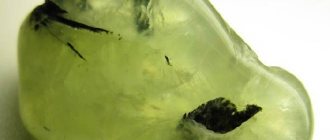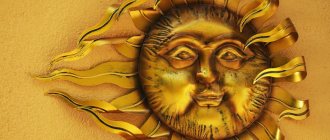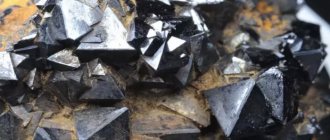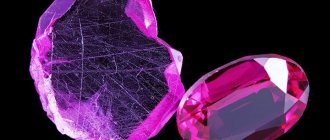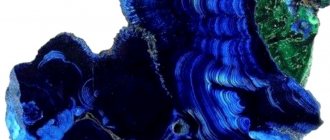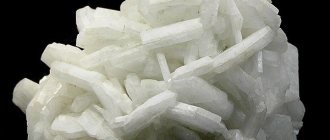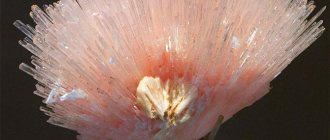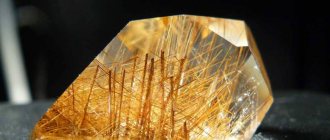Among the rare minerals from which almost no jewelry is made is Vivianite. It has a blue or bluish-green color. The stone is decorated with internal veins that form a complex and original pattern.
Vivianite is very sensitive to sunlight: it immediately darkens and becomes almost black. It is an iron oxide phosphate that has a pearlescent or glassy luster.
There are other names in the descriptions: blue ocher, blue earth, blue iron swamp ore, glaucosiderite, mullicite, kerchenite, bosphorite, paravivianite.
In nature there are almost transparent specimens, but they are extremely rare. Let's take a closer look at what vivianite is.
Origin story
The English name for the stone is Vivianite.
The first mentions date back to 1817. It was then that the stone was described by the famous mineralogist A. G. Werner from Germany.
The mineral was named after John Henry Vivian (1785 – 1855), who discovered vivianite in Carnaulla. This is a politician and mineralogist from England (Truro).
The stone is found in brown iron ores, peat bogs and lowland swamps, places rich in phosphorus and iron.
Often the “neighbors” of the stone are gypsum, barite, goethite, aragonite and limonite. The rock is white, almost transparent, when it comes into contact with air, it oxidizes.
Settlements [edit]
- Brazil. Cigana Mine, Galilee, Minas Gerais, with muscovite and pyrite. [13] Typically wedge-shaped crystals of vivianite are up to 11 cm in diameter, of medium luster, smoke-blue color and good transparency on a matrix of sharp silvery muscovite plates, some with druses of pyrite microcrystals. [14]
- Brazil: Llallagua, Potosi: Crystals up to 10 cm at the Siglio XX mine. [4] Clear bottle green crystals 10 cm from the San José/San Firmin vein. Vivianite typically occurs as prismatic crystals on a matrix of botryoidal goethite formed by alternating pyrite and marcasite. Specimens found in 2000 were associated with childrenite, cronstedtite, pyrrhotite, frankeite and pink massive sphalerite. [15]
- Cameroon: The world's largest vivianite crystals (over a meter long) made from mud. [9]
- Canada: in bog cast iron at Côte-Saint-Charles, Vaudreuil-Soulanges, Montérégie, Quebec. [4]
- Germany: In limonite ores in Amberg-Auerbach and in pegmatites in Hagendorf, Bavaria. [4]
- Japan: In Nagasawa, Iwama-machi, Ibaraki Prefecture, vivianite was found along fractures in rocks rich in graphite, pyrite and pyrrhotite. Vivianite is closely related to pyrite and occurs as very thin plate-like crystals up to 10 cm in length. [8]
- Kosovo. Trepča Mines, Stari Trg. Thick prismatic crystals up to 10 cm long and 2 cm thick, relatively stable. Deep green in color and transparent, usually based on pyrrhotite or pyrite, and in some cases based on quartz or carbonates. [16]
- Mexico: gem quality blue-green crystals up to 8 cm from the San Antonio mine, Santa Eulalia, Chihuahua. [4]
- Russia: in sedimentary iron ores and fossil shells on the Kerch and Taman Peninsulas of the Black Sea. [4] [9]
- Spain: at the Brunita mine, Cartagena, Murcia, vivianite was discovered in the form of dark green crystals up to 8 cm in size [17].
- USA: In diatomaceous earth on the bottom of a tertiary lake near Bureya, Shasta County, California. [4]
- USA: In Green Sand in Middletown, New Castle County, Delaware. [4]
- USA: Blackbird Mine, Lemhi County, Idaho. Crystals come in shades of pink, green, grayish blue, purple and purplish-black, as well as colorless. The unique deep purple color of some Blackbird Mine specimens is characteristic of the area. Some single crystals have both purple and green zones. Vivianite crystals from the Blackbird Mine are typically elongated and blade-shaped. They occur singly and in groups on dark altered slate and white quartz. Associated minerals include ludlamite, quartz and siderite. [18]
- USA: Abundant in pegmatites at Newry, Maine. [4]
- New Zealand: Small amounts of vivianite are present in sediments of Lake Kohangapiripiri. [19]
Properties
Photo of the mineral:
Vivianite is considered a hydrous iron phosphate and is classified among phosphates and their analogues. The plates are flexible and fragile. They do not dissolve in water, only in nitric and hydrochloric acid.
- IMA status is valid: the description was received before the IMA (before 1959).
- Class according to the taxonomy of the USSR - phosphates, arsenates, vanadates.
- IMA class: phosphates
Isolation form (morphology): flattened prismatic crystals, large sizes are extremely rare, but can reach 1.3 m.
They are often rounded or corroded; aggregates are globular, kidney-shaped, radially radiant; nodules, crusts, earthy masses; lamellar twins.
Physical properties
| Color | Green, greenish blue, blue, dark gray, colorless |
| Stroke color | Bluish-white, changing to black-blue, brown |
| Shine | Glass, pearlescent, dull |
| Kink | Splintered, fibrous. Flexible, can be cut with a knife. |
| Cleavage | Different: perfect, imperfect |
| Density | 2.68 g/cm3 |
| Mohs hardness | 1,5 – 2 |
| Transparency | Transparent, opaque, translucent |
In the blowpipe it turns red and fuses into a magnetic bead of shiny gray color (in a reduction flame). With phosphorus salt it produces glass, which is characteristic of iron.
If accumulated in a glass tube, it produces a large amount of water, which has a neutral reaction.
Visible changes: swells, becomes gray, turns red in areas.
Chemical composition
Blue Viviavit
- Formula: Fe32+[PO4]2 8H2O;
- Ferrous oxide (FeO) – 43.0%;
- Phosphorus pentaoxide (P2O5) – 28.3%;
- Water (H2O) – 28.7%;
- Ferric phosphate octahydrate (Fe3(PO4)2 x 8H2O).
Mn” sometimes replaces Fe” in small quantities. The ratio of other elements is expressed in the ratio Ca: Mn: Mg: Fe” = 1: 4.1: 5.6: 5.4.
Vivianite almost always contains a constant amount of ferric iron due to oxidation. The process is widespread in the crystal structure and does not change it, but the color of the mineral and its optical properties change.
How oxidation occurs has not been established, but presumably (H2O) turns into (HO) + H.
- Molecular weight: 501.61;
- Ratio: a:b:c = 0.75: 1: 0.35.
Cell parameters:
- a = 10.034 – 10.086 Å;
- b = 13.434 – 13.441 Å;
- c = 4.687 – 4.714 Å;
- β = 102.65° − 104.27°
Optical properties
- Pleochroism: visible;
- Dispersion of optical axes: r < v weak;
- Refractive indices: nα = 1.579 – 1.616 nβ = 1.602 – 1.656 nγ = 1.629 – 1.675;
- Birefringence (maximum): δ = 0.050 – 0.059;
- Optical relief: moderate.
Crystallographic properties
- Syngony: Monoclinic;
- Symmetry class: Prismatic – 2/T;
- Crystal structure: C2/t. a0 10.039 kX, b0 13.388, c0 4.687; р 104°18′; a0 : b0 : c0 = 0.7499 : 1 : 0.3501. The cell contains Fe6(PO4)4 x 16H2O.
Oxidation[edit]
Vivianite oxidation is an internal process; oxygen or water does not enter the mineral and does not leave it from the outside. A visible light photon knocks a proton out of a water molecule, leaving behind a hydroxide ion (OH - ). In turn, ferrous iron Fe 2+ loses an electron, turning into Fe 3+, i.e., it oxidizes and balances the charge. This process begins when visible light hits vivianite and can occur within minutes, dramatically changing the color of the mineral. Over time, vivianite changes to a new type - metavivianite Fe 2+ 2 Fe 3+ (PO 4 ) 2 (OH) · (H 2O) 7, which is usually found in the form of paramorphs after vivianite. [10]
Forms of location
Dark colorless Vivianite
Vivianite greenish shades
Indigo color vivianite
Needle-shaped or plate-shaped crystals of light green or transparent shades, changing color to indigo or dark blue in air - the most common type of vivianite.
Reason: oxidation. In the process, ferrous iron is oxidized to ferric iron.
From time to time, Vivianite is found in the form of earthy balls and nodules. Aggregates are fibrous or radiant. Thanks to the formation of vicinals, spear-shaped and lens-shaped formations are formed.
Crystals can be columnar or prismatic. Basically, their length is several centimeters, but there are rare specimens from 7 cm to a meter in length.
Natural Vivianite is often found in sedimentary iron ore rocks, sometimes in the bones of ancient animals.
In some cases, the mineral is characterized as a secondary material of iron ore caps, in the form of a clearly formed crystal.
It can also form as a residual product during weathering of primary phosphates containing iron and manganese in pegmatites.
Appearance[edit]
The mineral may occur as crystals, masses, or nodules. [4] The crystals are usually prismatic, parallel to the crystal c axis and flattened perpendicular to the b axis. Equant crystals are rarer. [1] [2] [4] They can also occur as stellate (star-shaped) groups or inlays with a spatulate or fibrous structure. [4] Unaltered specimens are colorless to very pale green, but they oxidize on exposure to light (and possibly also in situ) to blue, then dark green, brown, purple, and purplish-black. striped white, turning into dark blue or brown. The crystals are clear to translucent with a glassy luster, pearly on the chipped surface or dull and earthy. [1] [2] [3] [4]
Place of Birth
Vivianite is found quite often in:
- Romania;
- Czech Republic;
- Germany (found in limanite ores, brown coals, pegmatites);
- In areas where there were coal fires (in France, in Allier near Commantrie, in Aveyron near Cranzac);
- In places where there are tin veins: Great Britain (Cornwall), St. Agnes;
- Many in the USA (Shrewsbury and Allentown, Monmouth and Gloucester counties - the most);
- Russia (Urals, North Caucasus, European part, Murmansk region);
- Tatarstan;
- Ukraine;
- Cameroon;
- Bolivia;
- Crimea (Kerch Peninsula);
- Canada;
- Japan.
Geological setting[edit]
Vivianite is a secondary mineral found in a number of geological environments: oxidation zones of metal ore deposits, in granitic pegmatites containing phosphate minerals, in clays and glauconite deposits, and in modern alluvial deposits replacing organic materials such as peat, lignite, bog iron . ores and forest soils (All). Bones and teeth buried in peat bogs are sometimes replaced by vivianite. [9] Some authors say that it is particularly associated with gossan, but Petrov disputes this. [9]
Associated minerals include metavivianite, ludlamite, pyrite, siderite and pyrrhotite. [1] [9] Hydrothermal veins produce the best examples of classic green crystals. [9]
Type locality: Wheal Kine, West Wheal Kitty Group, St Agnes, St Agnes Parish, Cornwall, England. [2]
Medicinal properties
Vivianite is a mineral with unique healing properties.
Among them, lithotherapists note the following:
- The stone has a beneficial effect on the nervous system, calms, pacifies, eliminates anxiety and insomnia.
- Relieves stress and normalizes brain function.
- Recommended for those suffering from fears, phobias and nightmares, people with a sensitive nervous system and hyperexcitability.
- Helps improve vision and relieve symptoms of skin diseases: psoriasis, lichen, dermatitis.
The stone is not used in traditional medicine.
Impact on the human body
Medicinal properties
Lithotherapists attribute to vivianite a number of healing properties that the mineral can demonstrate, including:
- Positive effect on the nervous system, normalization of the condition;
- Minimizing stress manifestations;
- Calming influence;
- The ability to overcome certain phobias, frequent nightmares;
- Eliminate sleep problems.
Magic properties
Magicians talk about the stone as a nocturnal, excellent conductor of lunar energy. The reason for this characteristic is the ability of the mineral to darken in the sun.
Sorcerers, fortune tellers and the like try to keep vivianite nearby when organizing night rituals.
They say that the stone is especially strong and useful to the magician during the full moon. And the growth phase of the moon is the time when the stone actively drinks the energy of the night star.
It is important that the stone is in a place where moonlight will fall on it.
If a ritual or ceremony is performed on a full moon, then the stone will give its owner all the energy without reserve and will help the magician establish a close connection with his patron.
The lunar energy bestowed by the stone on the owner can be used by almost all zodiac signs, except Aries, Leo and Sagittarius.
To preserve the magical properties and usefulness of the stone, you should adhere to a number of rules:
- The stone cannot be passed from hand to hand; when the owner changes, it will lose contact with the owner, will not be useful to the new owner, and when returned to the first owner, contact will also not be restored;
- The stone must be stored in a case made of purple fabric, since this color is the moon’s favorite.
Magic properties
The mineral darkens under the influence of the Sun, which is why it is considered the Moon Night Stone. Psychics advise simply leaving it on the table overnight: the mineral will harmonize the space in the house and give the owners greater intuition and enhance the internal potential of strength.
It is used in some rituals, including esbats. Amulets are made very rarely.
More often they try to wear it as an individual amulet. Recommended in Feng Shui as a method of getting rid of excess solar energy.
How to store vivianite
If you don’t focus on the magic of the stone, then the most important rule is to protect the mineral from sunlight, so a thick fabric bag is the key to long-term preservation of vivianite.
When cleaning the stone, which can be done with a soft cloth, it is worth remembering that it is quite fragile.
Vivianite is a largely useful mineral that is interesting in the industrial field. The collectible value and magical properties of the stone will attract those who have found themselves in relevant fields.
Mineral and Zodiac signs
Mysterious and Lunar vivianite is suitable for all representatives of the astrological zodiac system. However, it is strictly not recommended for “Fiery” people to wear it: Leo, Sagittarius and Aries .
Impulsive, active and energetic signs will experience discomfort and even depression next to Vivianite, since they are energetically antipodes with it.
Application
Used as a fertilizer in agriculture on poor podzolic soils. Jewelry is practically not made, cutting can destroy the stone, it loses its properties.
Single, large-sized druses and crystals are used for private collections. And cryptocrystalline earthy specimens are taken as a pigment to make cheap indigo blue dye.
Interesting Facts
- Vivianite is often found on fossilized animal bones or teeth, and grows on organic remains. In 1877, a fossilized armored pterosaur was discovered in the area of Stuttgart (Germany). All his bone tissue was replaced with Vivianite.
- Vivianite crystals of a beautiful green hue are mined in Bolivia. They are used for jewelry.
